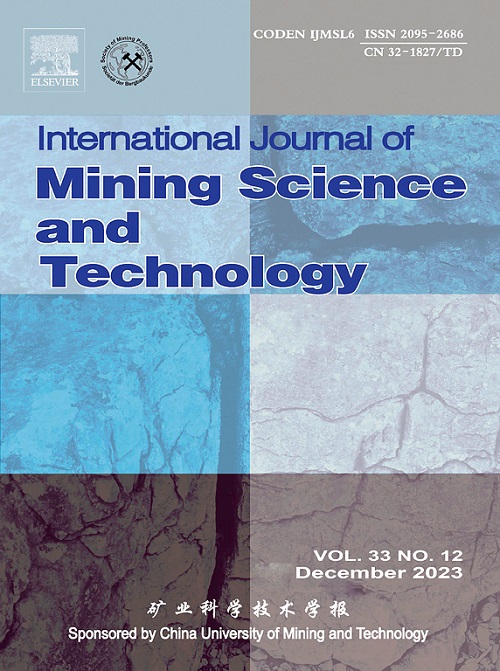Homogeneity-dependent fracture behavior and instability mechanism of composite coal-rock: Insights from three-point bending tests
IF 13.7
1区 工程技术
Q1 MINING & MINERAL PROCESSING
International Journal of Mining Science and Technology
Pub Date : 2025-06-01
DOI:10.1016/j.ijmst.2025.04.007
引用次数: 0
Abstract
To investigate the instability mechanisms of heterogeneous geological structures in goaf area roofs, three-point bending tests (TPBT) and numerical simulations are performed on composite coal-rock (CCR). Acoustic emission (AE) monitoring is employed to analyze key parameters, establishing a multi-parameter quantitative system for CCR fracture processes. The impact of lithological homogeneity on fracture evolution and energy migration is examined. Results show that CCR exhibits a three-stage mechanical response: weak contact, strong contact, and post-peak stages, each with distinct crack evolution patterns. A positive correlation is found between lithological homogeneity and tensile crack proportion. No significant correlation is observed between AE average frequency (AF) and AE counts across different lithological CCR; however, peak frequency (PF) displays clear lithology-dependent characteristics. The regulatory effect of the rock homogeneity coefficient () on crack derivation mechanisms is quantified, yielding mathematical relationships between fracture strength (), crack propagation path angle (), crack fractal dimension (), and . The study highlights how different fracture modes alter energy migration pathways, confirming the coupling effect of grain distribution on mechanical response and crack propagation, and the influence of parameter on critical energy release zones. These findings offer new insights into CCR failure mechanisms for mining safety.
煤岩复合材料均质性断裂行为及失稳机制:三点弯曲试验的启示
为研究采空区顶板非均质地质构造失稳机理,对煤岩复合材料(CCR)进行了三点弯曲试验和数值模拟。利用声发射(AE)监测对关键参数进行分析,建立了CCR断裂过程的多参数定量体系。研究了岩性均匀性对裂缝演化和能量运移的影响。结果表明:CCR表现为弱接触、强接触和峰后三个阶段的力学响应,每个阶段都有不同的裂纹演化模式;岩性均匀性与拉伸裂纹比例呈正相关。不同岩性CCR的声发射平均频率(AF)与声发射计数之间无显著相关性;然而,峰值频率(PF)显示出明显的岩性依赖特征。量化了岩石均匀性系数(φ)对裂纹衍生机制的调节作用,得到了断裂强度(f)、裂纹扩展路径角(β)、裂纹分形维数(D)和φ之间的数学关系。研究强调了不同断裂模式对能量迁移路径的影响,证实了晶粒分布对力学响应和裂纹扩展的耦合作用,以及参数φ对临界能量释放区的影响。这些发现为CCR失效机制的研究提供了新的思路。
本文章由计算机程序翻译,如有差异,请以英文原文为准。
求助全文
约1分钟内获得全文
求助全文
来源期刊

International Journal of Mining Science and Technology
Earth and Planetary Sciences-Geotechnical Engineering and Engineering Geology
CiteScore
19.10
自引率
11.90%
发文量
2541
审稿时长
44 days
期刊介绍:
The International Journal of Mining Science and Technology, founded in 1990 as the Journal of China University of Mining and Technology, is a monthly English-language journal. It publishes original research papers and high-quality reviews that explore the latest advancements in theories, methodologies, and applications within the realm of mining sciences and technologies. The journal serves as an international exchange forum for readers and authors worldwide involved in mining sciences and technologies. All papers undergo a peer-review process and meticulous editing by specialists and authorities, with the entire submission-to-publication process conducted electronically.
 求助内容:
求助内容: 应助结果提醒方式:
应助结果提醒方式:


